![]()
![]()
![]()
Use LEFT and RIGHT arrow keys to navigate between flashcards;
Use UP and DOWN arrow keys to flip the card;
H to show hint;
A reads text to speech;
55 Cards in this Set
- Front
- Back
|
is the bony section of the head and consists of cranium and facial bones. The ________ encases and protects the brain, houses the brain senses, provides attachments for muscles of the head and neck, and helps to form the first portions of the respiratory and digestive tracts.
|
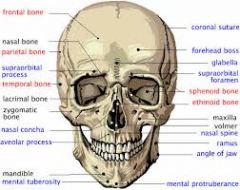
Skull
|
|
|
(lower jawbone) consists of a horizontal horseshoe-like body with a flat ramus projecting upward at each end. The rami are divided into two processes: the mandibular condyle and a front coronoid process. The mandibular condyles unite with the mandibular tissues of the temporal bones, while the coronoid processes serve as attachments for muscles used in chewing.
|
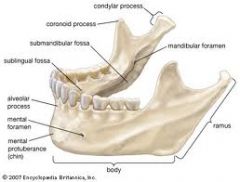
Mandible
|
|
|
consists of maxillary bones that form the upper jaw; together they are the keystone of the face, for all other immovable facial bones are connected to them. Portions of these bones make up the front of the roof of the mouth (hard palate), the floors of the orbits, and the sides and floor of the nasal cavity. They also contain the sockets of the upper teeth. Inside the maxillae, on the sides the nasal cavity, are the maxillary sinuses .
|

maxilla
|
|
|
forms the front portion of the skull above the eyes and includes the forehead, the roof of the nasal cavity, and the roofs of the orbits (bony sockets) of the eyes. On the upper margin of each orbit, the ________ is marked by a supraforamen (or supraorbital notch in some skulls), through which blood vessels and nerves pass to the tissues of the forehead. Within the _________ are two frontal sinuses, one above each eye near the midline.
|

frontal bone
|
|
|
is wedged between several other bones in the front of the cranium. It consists of a central part and two wing-like structures that extend sideways toward each side of the skull. This bone helps form the base of the cranium, the sides of the skull, and the floors and sides of the orbits (eye sockets). Along the middle, within the cranial cavity, a portion of the _____________ rises up and forms a saddle-shaped mass called sella turcica (Turk's saddle).
|
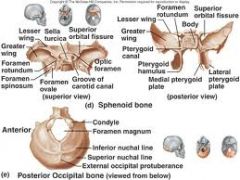
sphenoid bone
|
|
|
is one of two bones that form parts of the sides and base of the cranium. A _____________ on each side of the skull joins the parietal bone along the squamosal suture. The superior temporal line is the topmost curved line on the parietal bone and lies above the inferior temporal line. This is where the temporal fascia attaches. The inferior temporal line also lies on the parietal bone, and is the site of attachment of the temporal muscle.
|
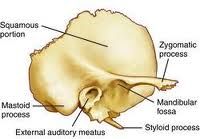
temporal bone
|
|
|
One is located on each side of the skull just behind the frontal bone. It is shaped like a curved plate and has four borders. Together,__________ form the bulging sides and roof of the cranium. They are fused in the middle along the sagittal suture, and they meet the frontal bone along the coronal suture. Where the two sutures meet is called the bregma. There is a gap through the _____________ that serves as a passageway for blood vessels and nerves, called the parietal foramen
|

parietal bone
|
|
|
joins the parietal bones along the lambdoidal suture. It forms the back of the skull and the base of the cranium. There is a large opening on its lower surface called the foramen magnum, through which nerve fibers from the brain pass and enter the vertebral canal to become part of the spinal cord. Rounded processes called occipital condyles, which are located on each side of the foramen magnum, unite with the first vertebra of the spinal column The junction of the sagittal and lambdoid sutures is called the lambda
|
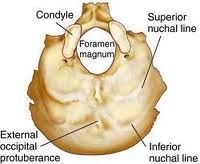
occipital bone
|
|
|
is one of two small, oblong bones that vary in size and form in different individuals. They lie side by side between the frontal processes of the maxillary bones and join to form the bridge of the nose. These bones serve as attachments for the cartilaginous tissues that are mostly responsible for the shape of the nose.
|
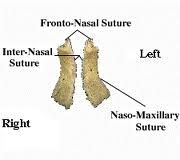
nasal bone
|
|
|
is one of two bones (sometimes called malar bones) that are responsible for the prominences of the cheeks below and to the sides of the eyes. These bones also help form the lateral walls and floors of the orbits (eye). Each bone has a temporal process, which extends down the back to join the zygomatic process of a temporal bone. Together, these processes form a zygomatic arch. The smooth prominence between the eyebrows is called the glabella.
|

zygomatic bone
|
|
|
A collection of 22 bones, ______ protects the all-important brain and supports the other soft tissues of the head. During fetal development, the bones of_____ form within tough, fibrous membranes in a fetus’ head. As these bones grow throughout fetal and childhood development, they begin to fuse together, forming a single___. The only bone that remains separate from the rest of ______ is the mandible, or jaw bone.
|
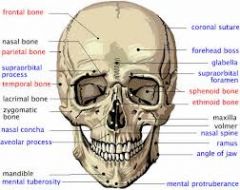
Skull
|
|
|
is where the two parietal bones are fused at the top of the head. It extends from the middle of the frontal bone to the angle of the occipital bone. It connects with the coronal suture.
|
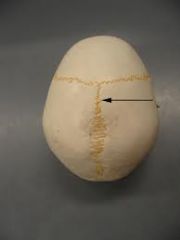
sagittal suture
|
|
|
is the area where the parietal bones (located on each side of the skull) meet the frontal bone.
|
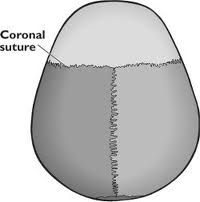
The coronal suture
|
|
|
is a U-shaped bone just under the mandible. The ____ is closely associated with the skull but is not strictly a part of it. It anchors muscles, especially those of the tongue, and is the only bone in the body that is not linked to another. The blood vessels into and out of the ________ are small branches of the external carotid artery, and are called superior thyroid arteries and superior thyroid veins.
|
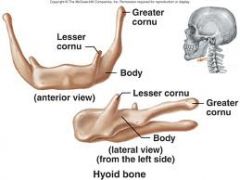
hyoid bone
|
|
|
is located in the posterior portion of the temporal bone. It is one of the two projections situated behind the ear. The ____________ provides an attachment for certain muscles of the neck.
|
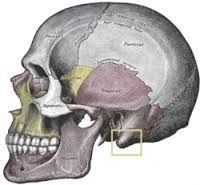
mastoid process
|
|
|
is the opening in the skull, which the spinal chord passes through to become the medulla oblongata.
|
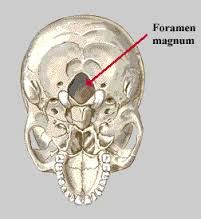
foramen magnum
|
|
|
is a prominent opening in the temporal bone, which is located behind (or posterior) to the mastoid process. Generally, it provides the opening through which a vein and artery pass.
|
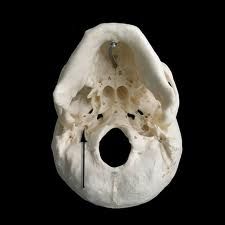
mastoid foramen
|
|
|
is an aperture in the temporal bone through which the internal carotid artery passes.
|
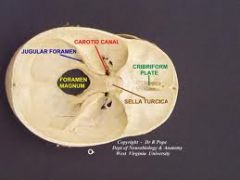
carotid canal
|
|
|
is a funnel-shaped opening communicating between the nasal opening and the pharynx
|
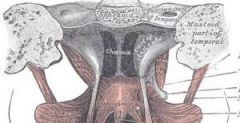
choanae
|
|
|
is below the second premolar located in the mandible. It transmits vessels and mental nerves.
|
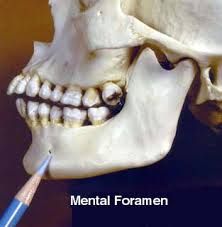
mental foramen
|
|
|
is above the fossa at the end of the infraorbital canal. It creates a perforation in the maxilla near the inferior margin and transfers the infraorbital vessels and nerve.
|
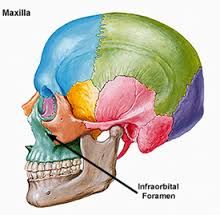
infraorbital foramen
|
|
|
is a long, flat bone that joins with the ethmoid bone to create the nasal septum.
|

vomer
|
|
|
are hard structures, set in the upper or lower jaw, and are used for chewing food. _____ also give shape to the face and aid in the process of speaking clearly.
|
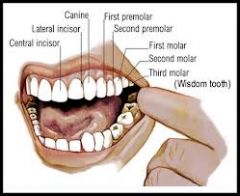
teeth
|
|
|
The permanent_____ usually appears in the seventh year of life and is part of the secondary, or permanent, teeth. The _________ teeth, or front teeth, precede the lateral incisors and start the arrangement of the teeth from the midline of the mouth. The ______ are chisel-shaped, and their sharp edges bite off relatively large pieces of food.
|
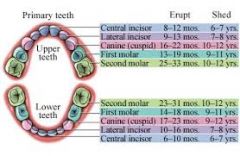
central incisor
|
|
|
The permanent___________ usually appears in the eighth year of life and is part of the secondary, or permanent, teeth. The ________ teeth, or front teeth, follow the central incisors and precede the cuspids in the arrangement of the teeth from the midline of the mouth. The _______ are chisel-shaped, and their sharp edges bite off relatively large pieces of food.
|
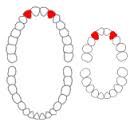
lateral incisor
|
|
|
The permanent ______ teeth usually appear in the eleventh or twelfth year of life and are part of the secondary, or permanent, teeth. The ______, or cuspid, teeth follow the lateral incisor and precede the first bicuspid (premolar) in the arrangement of the teeth from the midline of the mouth. The cuspids, _______ teeth, are cone-shaped, and they are useful in grasping or tearing food.
|
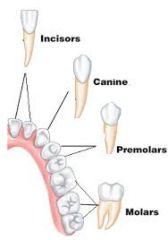
canine
|
|
|
The permanent ______ usually appears in the ninth year of life and is part of the secondary, or permanent, teeth. The ________, or bicuspid, is preceded by the cuspid and followed by the second bicuspid in the arrangement of the teeth from the midline of the mouth. The bicuspids have somewhat flattened surfaces and specialize in grinding food.
|
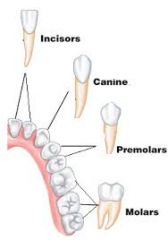
first premolar
|
|
|
The permanent _________ usually appears in the tenth year of life and is part of the secondary, or permanent, teeth. The _______ , or bicuspid, is preceded by the first bicuspid (premolar) and followed by the first molar in the arrangement of the teeth from the midline of the mouth. The bicuspids have somewhat flattened surfaces and specialize in grinding food.
|
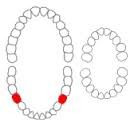
second premolar
|
|
|
The permanent __________ usually appears in the 12-13th year of life and is part of the secondary, or permanent, teeth. The __________ is preceded by the first molar and followed by the third molar in the arrangement of the teeth from the midline of the mouth. Molars have somewhat flattened surfaces and specialize in grinding food.
|
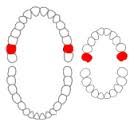
second molar
|
|
|
The permanent _____ usually appears in the 17-25th year of life and is part of the secondary, or permanent, teeth. The______ (sometimes called wisdom teeth) follow the second molars in the arrangement of the teeth from the midline of the mouth. The permanent teeth usually begin to appear at six years of age, but the set may not be completed until the__________ appear between 17 and 25 years of age. Sometimes these wisdom teeth become wedged in abnormal positions within the jaws and fail to erupt. These teeth are termed impacted. The molars have somewhat flattened surfaces and specialize in grinding food.
|
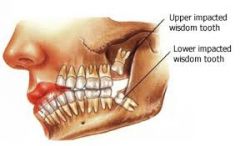
third molar
|
|
|
is located in front of the sphenoid bone. It consists of two masses, one on each side of the nasal cavity, which is joined horizontally by thin cribriform plates. These plates form part of the roof of the nasal cavity, and nerves (ethmoidal cells) associated with the sense of smell pass through tiny openings in them. Portions of the __________ also form sections of the cranial floor, eye sockets, and nasal cavity walls. A perpendicular plate projects downward in the middle...
|
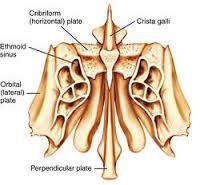
ethmoid bone
|
|
|
is a thin, scale like structure located in the middle wall of each eye socket between the ethmoid bone and the maxilla. A groove in the front leads from the orbit to the nasal cavity and provides a pathway for a tube that carries tears from the eye to the nasal cavity
|
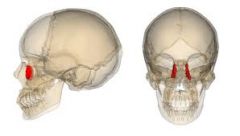
lacrimal bone
|
|
|
The__________ is a gap located at the lower edge of the temporal bones that leads inward to parts of the ear.
|

external acoustic meatus
|
|
|
The ___________ is located where the coronal suture and sagittal suture meet. It is on the border of the parietal bones. The parietal bones form the bulging sides and roof of the cranium. They are fused in the middle along the sagittal suture, and they met the frontal bone along the coronal suture.
|
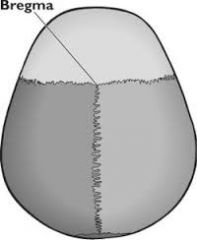
bregma
|
|
|
The ___ vertebra, known as the atlas vertebra, is the first or uppermost of the thirty-three (33) vertebrae of the spinal column and of the cervical vertebrae. The first and second cervical vertebrae are distinct from the other true vertebrae or movable vertebrae below them. As the superior of the seven (7) cervical vertebrae, the C1 is granted the nickname of the atlas vertebra in its role, together with the C2 axis vertebra, of supporting the skull where the head attaches to the neck
|
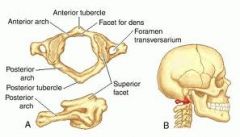
C1 or atlas
|
|
|
The_____ vertebra, known as the axis vertebra or the epistropheus, is the second-uppermost of the vertebrae making up the backbone and of the seven (7) cervical vertebrae at the top of the spine. Its nickname, the axis vertebra, derives from its role in allowing the head to rotate from its support atop the C1 vertebra where the skull attaches to the neck. As with the C1, the C2 vertebra is different from the other true vertebrae or moveable vertebrae below them.
|
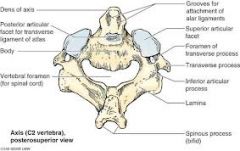
C2 or Axis
|
|
|
The__________________ sitting just below the C2 axis vertebra and the C1 atlas vertebra within the neck. After the C1 and C2 vertebrae, the C3-C6 vertebrae are often grouped together as very similar, and as with the other movable vertebrae they are characterized by two primary parts: a vertebral arch that protects the spinal cord and the centrum or ventral body that provides strength, protection, and mobility to the spinal column and thus to the body. The centrum is concave on its upper surface and convex below, with cartilaginous intervertebral discs providing cushioning between these surfaces and those of the respective inferior and superior articular facets of the adjacent vertebrae, simultaneously aiding the articulation between itself and the C2 vertebra above and the C4 below. Two transverse foramina interrupt the structure of the vertebral arch to allow for the passage of the vertebral artery and vein as well as the sympathetic nerves.
|
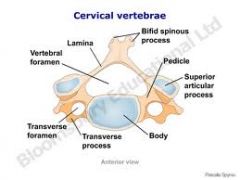
cervical vertebrae
|
|
|
Location of the 7 cervical vertebrae
|
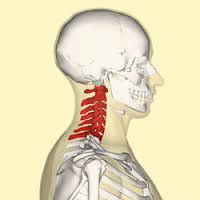
from the base of the skull to the top of the shoulders
|
|
|
The _____ vertebrae helps support and articulate the first rib and second rib on each side of the body with a demi-facet on the lower portion for the second rib and a complete articular facet atop the exterior of the centrum where the first rib's head connects.
|
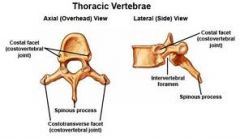
T1
|
|
|
They're connected to a pair of ribs, one on either side of the rib cage, through articular facets on the transverse processes. Costal demi-facets at top and bottom of the centrum provide additional space for articulation with the ribs.
|
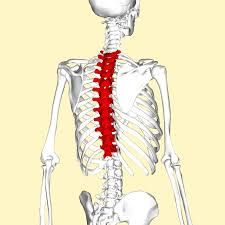
Thoracic vertebra
|
|
|
The______ vertebra is the uppermost or superior of the five (5) lumbar vertebrae below the thoracic vertebrae and above the fixed vertebrae of the sacrum.
|

L1
|
|
|
As the major weight-bearing bones of the spine, the ________________ are the largest of the movable or true vertebrae, with substantial ventral bodies or centrums that are more wide than deep.
|
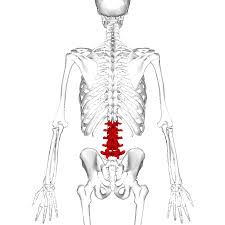
lumbar vertebrae
|
|
|
The ____ is a large triangular bone at the base of the lower spine. Its broad upper part joins the lowest lumbar vertebrae and its narrow lower part joins the coccyx or tail bone. The sides are connected to the iliums (the largest bones forming the pelvis). The ______ is a strong bone and rarely fractures. The five vertebrae that make up the ________ are separated in early life, but gradually become fused together between the eighteenth and thirtieth years.
|
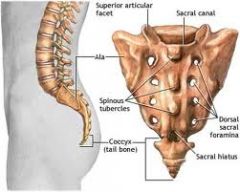
sacrum
|
|
|
The _____ (or tail) is the lowest part of the vertebral column and is attached by ligaments to the margins of the sacral hiatus. When a person is sitting, pressure is exerted on the _____, and it moves forward, acting sort of like a shock absorber.
|
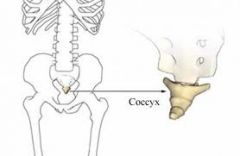
coccyx
|
|
|
The _______ is the collarbone. There are two of these bones, each curved a little like an f, that join the top of the breastbone (sternum) to the shoulder blade (scapula). The _____s support the arms and transmit force from the arms into the central skeleton.
|
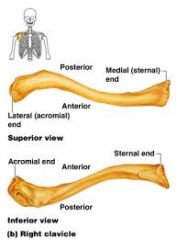
clavicle
|
|
|
The _______ is the technical name for the shoulder blade. It is a flat, triangular bone that lies over the back of the upper ribs. The rear surface can be felt under the skin. It serves as an attachment for some of the muscles and tendons of the arm, neck, chest and back and aids in the movements of the arm and shoulder. It is well padded with muscle so that great force is required to fracture it.
|
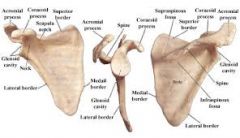
scapula
|
|
|
The _____ of the sternum is the upper portion of the sternum. The sides of the manubrium and the body are notched where they unite with costal cartilages.
|
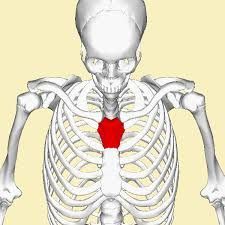
manubrium
|
|
|
The _________________ is the middle portion of the sternum, or breastbone, which is a long, narrow, flat plate that forms the center of the front of the chest. It develops in three parts. By middle life, the lower, xiphoid process, of the sternum will fuse to the __________. The sides of the manubrium and the body are notched where they unite with costal cartilages.
|
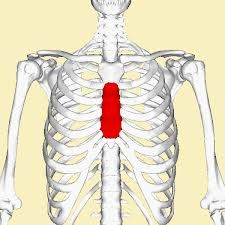
body of the sternum
|
|
|
The _____ is the medical name for the breastbone, a long, narrow, flat plate that forms the center of the front of the chest. It develops in three parts: an upper portion, or manubrium, a middle body, and a lower xiphoid process that projects down. The xiphoid process begins as a piece of cartilage. It slowly hardens into bone until, by middle life, it is usually fused to the body of the _____.
|
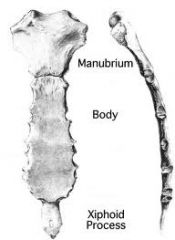
sternum
|
|
|
The _____ are attached to the sternum (breastbone) directly by their costal cartilages. There are seven ________.
|
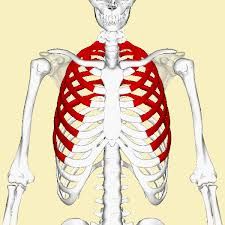
true ribs
|
|
|
The ____ are the remaining five pairs of ribs in which their cartilages do not reach the sternum directly. Instead, the cartilages of the upper three _____ join the cartilages attached to the ribs above.
|
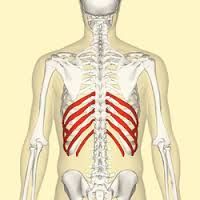
false ribs
|
|
|
The ____ is a set of hyaline cartilage bands that attach the medial end of the seven true ribs to the lateral border of the sternum (breastbone). __ (cost- = rib) ___ also connects the three superior false ribs to the sternum, but these false ribs are attached indirectly by way of the seventh true rib’s cartilage band.
|

costal cartilage
|
|
|
The ___ is the bone of the upper arm. The smooth, dome-shaped head of the bone lies at an angle to the shaft and fits into a shallow socket of the scapula (shoulder blade) to form the shoulder joint. Below the head, the bone narrows to form a cylindrical shaft. It flattens and widens at the lower end and, at its base, it joins with the bones of the lower arm (the ulna and radius) to make up the elbow
|
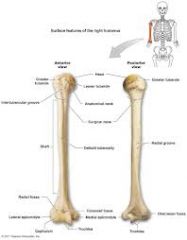
humerus
|
|
|
The _____ is the shorter of the two long bones of the forearm. The other is the ulna. The ____is the bone on the thumb side of the arm. The shaft of the ______has a broad base that joins the lower end of the ulna and the upper bones of the wrist at a large process called the radial styloid. The disk-shaped head of the radius, which is smaller than the base, joins the lower end of the humerus (bone in the upper arm) to form the elbow joint.
|
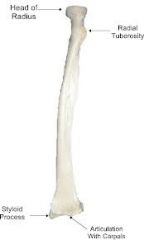
radius
|
|
|
The ______ is the longer of the two bones of the forearm, the other being the radius. When the palm faces forward, the _____is the inner bone (the one nearest the body) running down the forearm parallel to the radius. The upper end joins with the radius and extends into a rounded projection that fits around the lower end of the humerus (the upper arm bone) to form the elbow joint. The lower end of the _____ is rounded and forms a joint with the wrist bones and lower end of the radius.
|
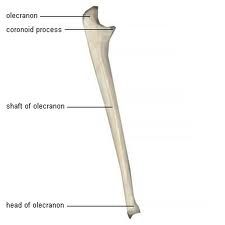
ulna
|

